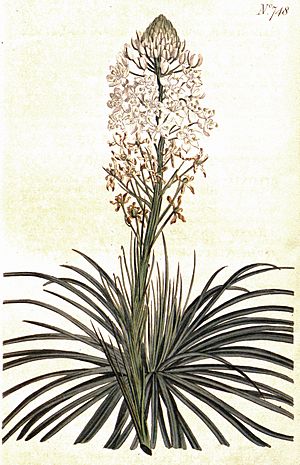Turkey beard facts for kids
Quick facts for kids Turkey beard |
|
|---|---|
 |
|
| 1804 illustration | |
| Conservation status | |
| Scientific classification | |
| Genus: |
Xerophyllum (plant)
|
| Species: |
asphodeloides
|
| Synonyms | |
|
|
Xerophyllum asphodeloides is a cool flowering plant from North America. People often call it turkey beard because its flowers look a bit like a turkey's beard! It's also known as eastern turkeybeard, beartongue, grass-leaved helonias, and mountain asphodel. This plant grows in the eastern United States. You can find it in the southern Appalachian Mountains, from Virginia all the way to Alabama. It also lives in the unique Pine Barrens area of New Jersey.
About Turkey Beard
The turkey beard plant is a type of perennial herb. This means it lives for more than two years. It grows from a special underground stem called a rhizome. This rhizome helps the plant spread.
What It Looks Like
Turkey beard can grow quite tall, sometimes up to 1.5 meters (about 5 feet). Its leaves are long and thin, like threads or grass blades. They can be up to 50 centimeters (about 20 inches) long. The edges of the leaves are slightly saw-toothed.
The plant's flowers grow on a tall stalk. This stalk is called an inflorescence. The flowers are cream-white and have six petal-like parts called tepals. After the flowers bloom, they turn into small fruits. These fruits are like little seed pods, called capsules.
Where It Grows
Turkey beard is most common in New Jersey and Virginia. It is less common in other parts of its range. It likes to grow in areas with certain types of trees. These include different kinds of oak trees, like chestnut oak and blackjack oak. It also grows near pine trees, such as shortleaf pine and pitch pine.
Many other plants grow near turkey beard. Some of these include sassafras trees and various types of asters. You might also spot pink lady's-slipper orchids nearby. Other common neighbors are black huckleberry and different kinds of blueberries.
Why It Needs Our Help
Sadly, the turkey beard plant is facing some challenges. Its home, or habitat, is shrinking. This happens when land is used for buildings or roads. When habitats get smaller, they can also become broken up. This is called habitat fragmentation. It makes it harder for plants to spread.
Another problem is fire suppression. This means preventing natural wildfires. Some plants, like turkey beard, actually need occasional fires. Fires help clear out old plants and make space for new growth. Without fire, other plants can grow too much and block the sunlight. This makes it hard for turkey beard to thrive. Protecting its habitat and understanding its needs are important for keeping this unique plant around.


